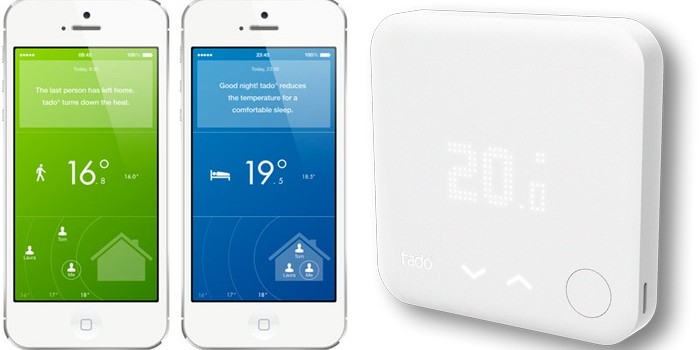
Smart heating controls
If you get a new heating system installed today, the chances are it will be installed with a thermostat and a programmer. In many cases, TRVs are also installed on radiators to give people a further level of heating control.
The heating pattern set by the programmer and thermostat (to limit the upper temperature the house gets heated to), should match your heating requirements – and the closer you can match them, the more you will save.
What is the issue with standard heating controls?
During the day you might want different temperatures in the home, or for the heating to come on based on a slightly different pattern than the programmer is programmed to do. The ability to further refine the level of heating controls in the home results in even larger savings – and there are big companies like Google investing £millions to help drive home automation and smart heating controls.
There are loads of different companies currently producing smart heating controls – for example Honeywell with their EvoHome offering, Google with their Nest smart thermostat and the newer Tado thermostat.
While many companies are entering the smart heating control market, there are a lot of similar features within the units they develop. Here we take a look at some of those features to see if you could fine-tune your heating system.
Ability to control your heating using an app
This is now central to most of the smart heating controls out there. While you might not be able to alter individual room temperatures, pretty much all of them have an app (normally available on smart phone, tablet and online) that allows you to turn the heating on or off from wherever you are in the world. Add in to the mix a remote-controlled thermostat and you can set average temperature your home will reach – all with the tap of a finger.
This is a great feature, especially if like us you forget to turn off the heating/hot water when you go on holiday. Obviously you won’t want to turn the heating off completely in the middle of winter in case the pipes freeze, but if you aren’t in the house, heating it to 20 degrees is just a waste of money.
 A heating control system that learns
A heating control system that learns
While this sounds like something out of Terminator, it’s not scary, but it is clever! Smart controls use a combination of sensors, hardware and algorithms to make heating decisions. As you’d expect they have temperature sensors, but they also often have light or movement sensors, humidity sensors and even up-to-date weather information from an external source via a wifi connection. This allows the heating system to learn your behaviour and the temperature you like, and then set the heating accordingly.
Some of the older smart thermostats like Nest, (that is just a single thermostat – albeit a smart one), will only make these calculations based on one location in the house; but some of the more advanced smart heating controls (like the Heat Genius system for example) have sensors in lots of different locations – this allows the system to develop a much more accurate heating pattern.
Remote controlled electronic TRVs
TRVs are the thermostatic valves found on radiators. These all allow you to control the temperature of individual rooms and are normally manually set with a bezel, typically allowing you to set the heating at a level between 1 and 5. They work when a wax or liquid-filled capsule expand or contract when the room gets hot or cold, causing it to close or open the radiator to new hot water.
Electronic TRVs are a newer invention, and are key to the more sophisticated smart heating controls. Instead of the expansion or contraction of a material, they are mechanical and read the temperature of the air using an electronic thermometer.
The best electric TRVs are then controlled remotely from a central thermostat. This gives you the easiest way to control the temperature of individual rooms, again allowing you to warm up a spare room if you have someone over to stay or likewise turn down the heating if the kids are away at university during term time.
The EvoHome system and the Heat Genius systems both have remote controlled TRVs that can be controlled centrally by an app on a phone or the control panel (in the case of EvoHome).
Geo fencing
Geo fencing is a relatively new technology and takes advantage of your phone signal. Your phone tracks exactly where you are in the country and then as you approach home it will turn the heating on for you. Likewise when you leave home in the morning it will turn the heating down, all without you having to do anything. This is a bit of an extension to the smart thermostat learning ability, but again it is directly coordinating your heating based on your behaviour.
The one downside of this (or at least a downside experienced when we tested a model) was the rate at which the phone battery died when you have location services turned on, but with technology developing, this hopefully won’t be an issue for long.
Energy usage
Aside from just the ability to turn your phone into a mobile control panel for your heating, some of the apps that come with the smart heating systems also can show your actual usage, projected usage, cost etc etc. The Tado is particularly good here and as time goes on this feature will no doubt be used in all the apps that are built.
The future of smart heating controls
As time goes on, smart heating control manufacturers will come up with new and improved ways to make smart heating controls even better. We will continue to update this page as we hear about these great new features so be sure to come back and check it out!
Think we missed something? Do you have a different opinion?
Comment below to get your voice heard…












Hello, How can i buy for smart heating controls. I’m form Mongolia. I will buy smart heating controls for sale to my customers.
I am looking for a remote control system for the heating in a second home in the UK. Your reviews are very helpful. One issue that you do not mention is control of access to the data. Who gets access to information about my heating usage and how can I restrict access. Any information would be much appreciated
Hi, I think it depends on the manufacturer of the specific smart heating controls you are looking at. I know we have spoken to one recently who is enrolling on the Governments demand side management energy system. For example they use all usage data and can basically remotely turn off individuals heating systems to help reduce demand on the grid. Obviously users can opt out, but it is just one way in which this data is being used. I think on the whole most of the data sent in gets sent anonymously but if you are worried I would speak directly to the manufacturers of the smart heating control.
I wish to use a Tado Extension Kit to replace my controller however my current controller (Horstmann H37XL) is 3 channel whereas the Tado is only 2.
Can i wire both heating channels from the Horstmann into 1 channel on the Tado?
As each zone now has its own smart thermostat i have no need to be able to time each zone seperately.
The geofencing with Tado now requires a £1.99 subscription per month which would probably knock out any money savings!
I have installed battery operated, programmable TRV’s on my radiators. These control the temperature in each room – e.g. Bedrooms @ 17 daytime & 20 night – living rooms 23.5 daytime and 17 night. Previously, the system was ontrolled by a single programmable room thermostat in the living room and a Honeywell ST6400C controller near the boiler. To avoid the thermostats arguing, I set the room stat to 23.5..
Now the 230v controls have failed and I have no heat. Water heating is by electricity so does not affect matters
I’m no electronics expert, just an architect 22 years retired, but I’ve given it some thought and conclude that, with the battery controlled TRV’s, I will only need an overiding mains room-stat (set at the TRV highest temperature) that will turn off the boiler and pump when no heat is required.
It surely can’t be as simple as that. Please can you advise.